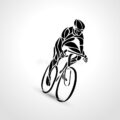The average hybrid bike is faster than a mountain bike by up to 3.9% on flat roads. When you head to slight inclines of about 5% grade the hybrid will still be faster by about 2.9%.
It is important to note that when it comes to hybrid vs mountain bike speed margins are smaller even when the speeds go over 40 km/h which in essence means the mountain bike and hybrid bike are very close in speed even though the hybrid has a slight edge.
WHAT IS A GOOD MOUNTAIN BIKE SPEED?
17 miles an hour is deemed a good average speed for riding a mountain bike on the road. On mountain bike trails speed can drop dramatically to 14 mph given the varied terrain that often comes with more obstacles, inclines, and drops as compared to paved surfaces.
WHAT IS A GOOD SPEED ON A HYBRID BIKE?
The average hybrid bike can attain speeds of between 12 to 18 miles an hour on flat paved surfaces. Some hybrid bikes are designed with multiple gears which helps achieve higher speeds depending on the riding conditions.
Check out the best hybrid bikes under 1000 here
DIFFERENCES BETWEEN A MOUNTAIN BIKE AND A HYBRID
The major differences between the mountain bike and hybrid bike are that the hybrid has a more aerodynamic and lightweight frame, rim instead of disc brakes smooth thinner tires with most having no suspension.
For these reasons, the hybrid is better for dirt paths, gravel, or paved roads rather than rugged trails or offroading as compared to a mountain bike.
Even though these are just some of the differences between hybrid bikes and mountain bikes, there are several more that includes the one in the comparison chart.
KEY DIFFERENCES BETWEEN A HYBRID AND A MOUNTAIN BIKE
- The Frame
The frame is one of the most obvious differences between a mountain bike and a hybrid bike is a frame. The hybrid bike frame is closer to the road bike rather than a mountain bike.
Hybrids also tend to have lighter and slimmer frames as compared to mountain bikes as they are not exposed to extreme riding conditions. As such road bikes tend to have more aerodynamic frame designs that make them faster on the roads.
Since aerodynamics and weight are less important in mountain biking which is outweighed by the need for frame strength and robustness, the mountain bike has a heavier and less aerodynamic frame.
- Suspension
The next major difference between mountain bikes and hybrid bikes is suspension. Given that hybrids are usually ridden on paved roads, they will usually not need a suspension.
The wider tires and lower tire pressure allows a hybrid to handle most of the road bumps that would make a road bike ride uncomfortable. Moreover, suspensions only add weight and make a bike more exp[ensive hence they tend to not be included in hybrids.
However, you should note that some hybrid bikes come with basic suspension which means that you can take them on less punishing trails.

- Brakes
Many hybrid bikes come with traditional rim brakes even though there are some that use disc brakes. Rim brakes are usually cheaper, lighter, and easier to judge wear, and replace.
This means hybrid bikes are ideal for casual riding and short commutes as they usually have relatively flat commutes and slower speeds are more common and as such, the more expensive disc brakes are unnecessary in most instances.
Given that weight is usually not that much of a concern on mountain bikes, they tend to use disc brakes. The disc brakes are usually stronger and have more stopping power which is much needed when riding down steep descents on mountain bikes.
- Gearing
Mountain bikes usually go on all manner of riding conditions from extreme climbs, steep downhill descents, and easy flats. As such mountain bikes usually come with a wide gearing range to deal with different riding conditions.
On the other hand, hybrid bikes are ridden for the most part on flat roads and medium-grade inclines, and as such fewer gear ratios are desired. Fewer gears usually mean less weight and are cheaper even as they improve efficiency riding on the road.

- Tires
Mountain bikes are usually equipped with knobby big burly tires for better traction on wet, dry trails, or anything in between. However, these knobby tires will slow one down riding on paved surfaces.
The extra width and knobby tires slow one down as they cause a lot of friction. On the other hand, the smooth thinner tires of a hybrid bike have less rolling friction which makes them cruise more efficiently on roads.
However, you should note that hybrids are wider tires than road bikes so that they can handle the occasional gravel or dirt trail. The extra width also makes the hybrid more comfortable on roads as compared to the road bike.
Hybrid bike tires also require higher pressures of between 40-70 PSI as compared to the 20-35 PSI for mountain bike tires. Given that hybrid bikes are a combination of road bikes and mountain bikes their tire pressure is between the optimal for a mountain and a road bike.
Lastly, hybrids usually come with 28-inch 700c tires which is the standard for road bikes as compared to the 27.5 or 29-inch mountain bike tires.
- Cargo Racks and Fenders
Many hybrid bikes come with cargo racks and fenders since they are often used as commuter bikes. Since you do not want to get water and dirt onto your clothes fenders come in handy if you are cycling to work.
Mountain bikes tend to not have fenders and cargo racks as they are typically not used for commuting. However, you can install a rack or fender on a mountain bike if you intend to use it for commuting.
You can typically reduce the weight of your bike by removing the fenders and cargo rakes for some marginal increase in speed.

- Handlebars
Even though most mountain bikes and hybrids use a riser or flat handlebars, some hybrids may have mustache or drop bars for more efficient riding on roads.
Almost no mountain bike will come with drop bars or mustache handlebars as trail riding requires more stability rather than aerodynamic positions as compared to hybrid bikes that are ridden on smooth and more predictable terrain.
- Seats
Since hybrids are typically used for fun and casual riding situations, most are not designed for performance but rather for comfort. As such, most hybrids come with more comfortable wider sets that do not need chammy or padded shorts
Since performance is very critical for mountain biking, mountain bikes come with more aggressive seats that enhance performance on the difficult terrain they are ridden on.


